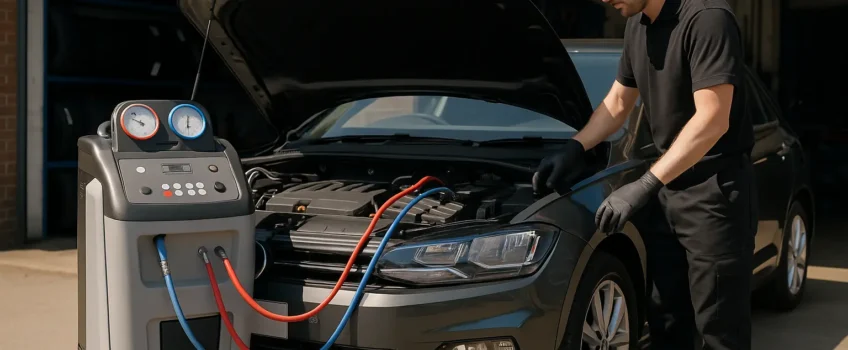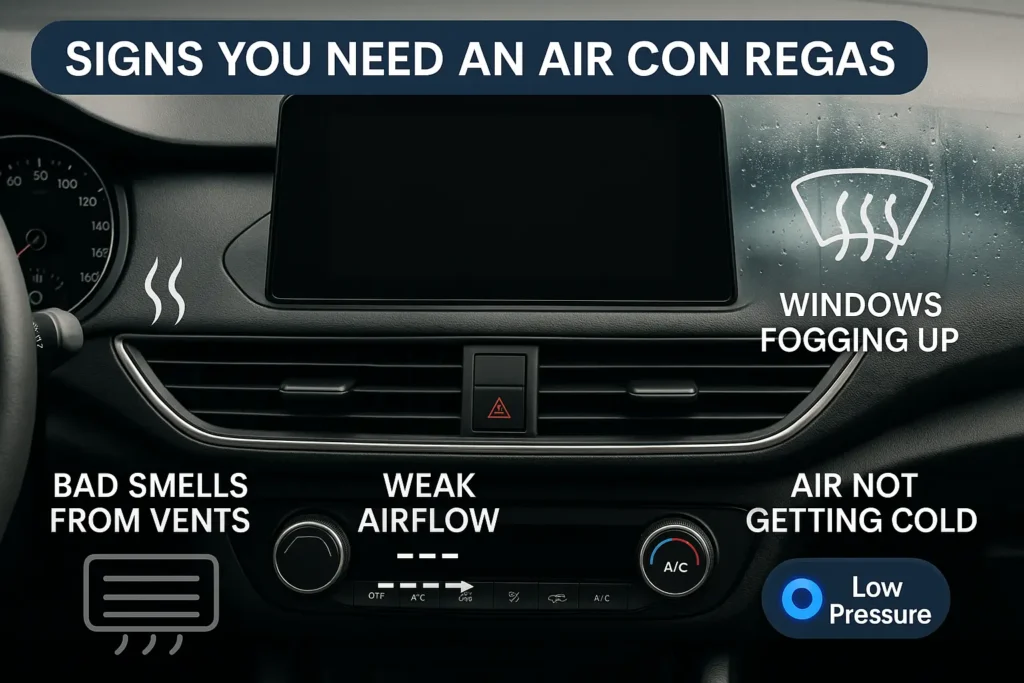
The When, Why, and How of Air Con Regas
Your car’s air conditioning system does more than just cool the cabin in summer. It also helps demist windows, maintain air quality, and keep your vehicle’s internal systems running efficiently. One of the key ways to keep your air conditioning system working its best is through regular air con regas. In this guide, we’ll explore how it works, when you need it, and why using your air con all year long is more important than you might think.
What Is Air Con Regas and Why Is It Important?
An air con regas, short for re-gassing, is the process of refilling your car’s air conditioning system with refrigerant gas. Over time, this gas naturally escapes through the system’s seals and components, reducing performance. Without enough refrigerant, your air con will struggle to cool the air, demist windows, or function efficiently.
Not only can this make your drives uncomfortable, but it can also place strain on your vehicle’s air con compressor and increase your fuel consumption. Booking an air con service that includes regassing ensures everything is running as it should.
Understanding Refrigerants and Why They Matter
Refrigerant is the lifeblood of your vehicle’s air conditioning system. Most modern vehicles use either R134a or R1234yf. These gases absorb heat from inside the car and release it outside, making it possible to maintain a cool temperature in the cabin.
Due to environmental regulations, older refrigerants have been phased out in favour of more eco-friendly alternatives. It’s vital to ensure the right gas is used for your vehicle. Attempting a DIY regas with the wrong type can cause long-term damage or even legal issues.
When Should You Get an Air Con Regas?
It’s generally recommended to have your air con system regassed every two years, but that depends on your vehicle usage. Some drivers may need it sooner if they frequently use their air con or notice performance drops.
Signs you need an air con regas:
- Warm air blowing despite AC being on
- Weak airflow
- Unusual smells when the system is in use
- Windows fogging up more frequently
- Increased fuel consumption
Find out more in our detailed post about how often to check your air con.
How Air Con Regas Affects Fuel Efficiency
Contrary to popular belief, a properly functioning air conditioning system can be more fuel-efficient than driving with windows down, especially at higher speeds. Open windows increase aerodynamic drag, which puts more strain on your engine.
According to HowStuffWorks, using air con at motorway speeds can actually be more efficient than windows down. However, an undercharged air con system can drag down fuel economy, as the compressor must work harder to produce cool air.
Using Air Con in Winter: Why It Matters
Your car’s air con isn’t just for summer. In the colder months, using it regularly helps keep the system lubricated and prevents components like seals and hoses from drying out. It also plays a crucial role in demisting your windscreen and side windows.
When you use air con in winter, you’re reducing the moisture in the air, which speeds up defogging and improves visibility. Read more in our article about the benefits of using your air con in winter.
Air Con Regas vs. Air Con Service: What’s the Difference?
Many drivers confuse a regas with a full air con service. While regassing is a key part of air con maintenance, a full service includes:
- Leak detection
- Pressure testing
- Component inspection
- Antibacterial clean to remove mould and odours
If you’re experiencing ongoing issues or haven’t had your air con checked in a while, booking a full air con service is the best way to ensure long-term reliability.
What Happens If You Never Regas Your Air Con?
Skipping regular regassing might not seem serious, but it can lead to:
- Strain on the compressor
- Loss of cooling performance
- Foul odours from moisture and bacteria build-up
- Poor visibility in winter from ineffective demisting
Eventually, lack of maintenance can result in major component failures, which are far more expensive than a simple regas.
Can You Regas Your Air Con Yourself?
DIY regas kits are available, but they come with risks. Without proper tools and knowledge, you might:
- Use the wrong refrigerant
- Overfill the system
- Fail to detect leaks
- Miss signs of deeper issues
Professionals use equipment to safely evacuate the old gas, vacuum the system, check for leaks, and refill with the exact refrigerant level required. That’s why we always recommend having your air con regas done at a professional service centre.
Related Services That Support Air Con Efficiency
Elite Garages offers a wide range of vehicle services that work hand-in-hand with air conditioning efficiency:
- Tyre Safety Checks: Properly inflated tyres improve fuel economy and driving comfort.
- Wheel Alignment: Misaligned wheels can cause unnecessary drag, placing strain on your car’s systems.
- Vehicle Diagnostics: Catch potential electrical or sensor issues early.
Whether you’re booking a summer road trip or keeping your car healthy through the winter, don’t overlook your air con system. A simple regas could make all the difference.
FAQs: Air Con Regas
Click the + to read any answer or then either a category or tag to view all questions under that category or tag.
To keep your car air con in optimal condition, it is recommended to have the system serviced regularly. Most vehicle manufacturers recommend servicing your air conditioning every two years or 30 000 miles, whichever comes first. However, this may vary depending on the age of the unit and how heavily it has been used.
Car air conditioning problems can be difficult to diagnose without the right tools and expertise. If you suspect there is an issue with your car’s AC, it is best to take it to a professional vehicle technician who has the experience and tools necessary to accurately assess and repair the problem.
Common car AC problems include low refrigerant levels, blocked condenser or evaporator coils, a faulty compressor and damaged wiring or hoses. To identify the root cause of the problem, technicians will typically start by checking for any possible leaks.
They will also check for proper refrigerant levels and inspect the compressor and other components for signs of wear and damage. If necessary, they may also conduct a dye test to reveal any hidden leaks that cannot be seen on the surface.
When checking your air con, you should first do a visual inspection. Look for signs of wear and tear and make sure all parts are properly connected and secured. Check the external unit and fan to ensure they are free from debris or dust. Inspect the indoor coils for any damage or dirt buildup. Check the filters for any clogs or blockages which can affect the airflow. Make sure to change or clean the filters regularly. With that said, it’s always best to acquire the services of an expert vehicle technician.
About Us
Opening Times
Saturday : 8:30–4:00
Sunday : closed
More Information
Contact UsCustomer Information Pack
Check MOT Due Date
Free MOT reminder
Careers



